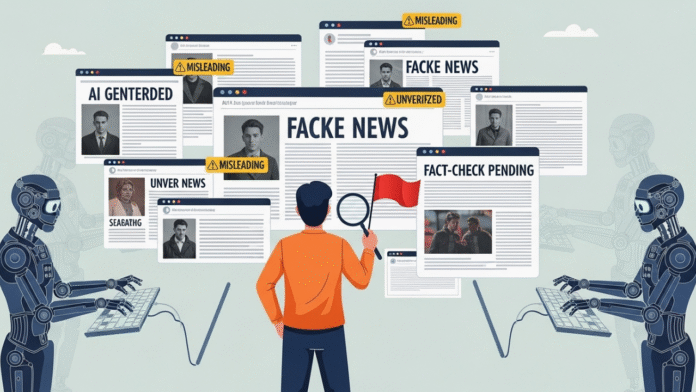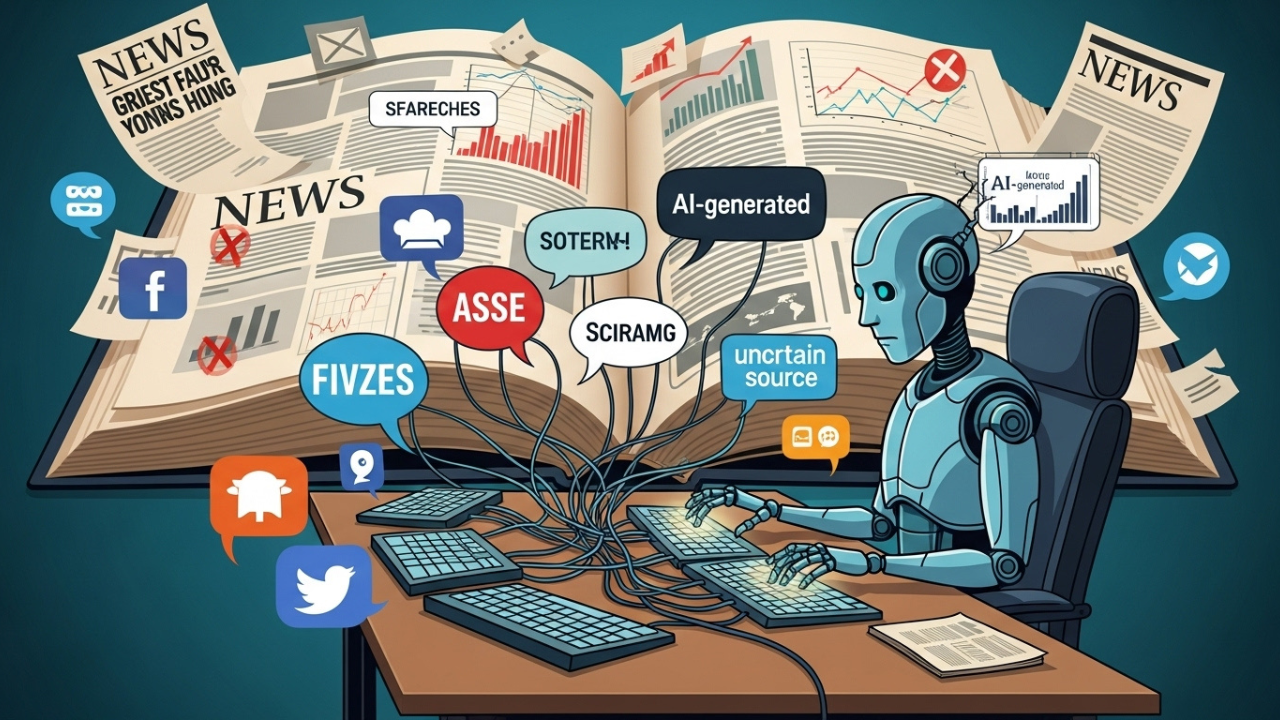A Guide for a New Era: How AI is Used to Spread Misinformation (and How to Fight It)
AI is all around you now. It writes emails, suggests replies, summarises articles, and even helps you make decisions. It saves time. It makes work faster. And it speaks in a tone that feels smooth, confident, and useful.
But sometimes, it’s wrong. And not just a little wrong — dangerously, confidently, and convincingly wrong.
This is how AI helps spread misinformation. Not because it wants to. Not because it understands what truth is. But because it can generate believable content in seconds, without stopping to check if any of it is actually true.
If you’re reading this, you likely use AI tools or know someone who does. This guide is here to help you understand how misinformation spreads through these tools, why it happens, and most importantly, how you can spot it and prevent it from doing harm.
What Is Misinformation — and Why AI Makes It Worse
Misinformation means that something is factually incorrect information, usually distributed as though it were accurate. It may go as viral as a fake quote that circulates on social media, or as innocent as a misdated item of news.
What makes AI dangerous in this area is not that it lies — it’s that it writes fluently, instantly, and at scale. That means:
It sounds human
It writes fast
And it can be used by anyone — intentionally or not — to spread false claims
The real issue? People trust what sounds smart. And AI usually sounds very smart. That combination — fast, believable, and unchecked — is the perfect recipe for misinformation to spread quickly and widely.
How AI Spreads Misinformation (Not Always on Purpose)
You just need to learn this: the majority of tools used in AI are not intended to be deployed in lying. They are designed in order to guess the next word of a sentence. They don’t know the truth. They don’t fact-check. They don’t pause when they’re unsure. They just keep writing.
Here’s how that goes wrong.
AI Is Trained on Biased or False Data
AI learns by reading billions of examples — web pages, books, forum posts, articles. But the internet is full of mistakes, opinions, outdated facts, and sometimes pure fiction.
If the model sees false statements repeated often enough, it might treat them as correct patterns and repeat them later in your conversation.
It’s not trying to trick you. It’s just repeating what it learned — even if it was wrong.
It Fills Gaps With “Best Guesses”
When AI does not know something, it does not get into pause and apologise, saying, I do not know. It rather attempts to come up with something that matches the pattern.
This is called hallucination — when the AI makes something up because it feels like the “right” thing to say next. That includes:
- Fake statistics
- Invented quotes
- Nonexistent research
- Misattributed fact
You can ask, “Who won the 2009 Nobel Peace Prize?” and it might say the wrong name with total confidence — even if it never saw the correct answer in its training data.
It Writes at Scale — and Fast
One person using AI to write 50 blog posts in an hour isn’t hard to imagine. But what if those posts all include one wrong fact? That’s 50 pieces of misinformation now online — written faster than any editor can review them.
Multiply that by millions of users, and you see the risk: AI allows bad or inaccurate content to scale like never before.
The Content Gets Shared Without Being Checked
AI-written content often ends up on:
- Social media
- Forums
- Newsletters
- Video scripts
- Podcasts
- Emails
- Text messages
Most of it gets copied and shared quickly. If readers assume it’s trustworthy just because it “sounds good,” false information spreads far and fast, before anyone catches the error.
Real Examples of AI-Driven Misinformation
This isn’t just a theory. It’s already happening. Here are real cases that show how AI can — and does — spread misinformation:
Fake News Articles Flooding Social Media
Some groups are using AI to write hundreds of articles on political topics, designed to mislead, confuse, or sway opinions. The articles look real. The tone is neutral. The quotes feel solid.
But behind it? No verified sources. No real journalists. Just AI rewording low-quality or false claims in a way that feels polished and trustworthy.
People read them, believe them, and share them — all within minutes.
Fabricated Quotes and Sources
A user might ask AI to “give me a quote from a famous scientist about technology.” The model might say:
“As Dr. Sylvia Barnes once said, ‘AI is the greatest mirror humanity has ever built.’”
Looks great. But Dr. Sylvia Barnes doesn’t exist. And the quote? Fully fabricated.
Someone copies it into an article, adds a photo, and the lie becomes part of the public record. People start repeating it. And no one stops to ask if it’s real.
Deepfake Scripts and Narratives
AI doesn’t just write blog posts. It writes dialogue, video scripts, and fake conversations. That content can be used in deepfake videos, where AI-generated faces speak AI-generated lies.
In politics, entertainment, or public health, this kind of fake media can mislead millions before it’s caught.
AI Chatbots Reinforcing Myths
People use AI to answer complex or controversial questions, often without knowing that AI pulls from unverified internet sources.
Ask, “Did humans live alongside dinosaurs?” and you might get an answer that suggests it’s possible, with “sources” that sound academic, but are misleading or fictional.
The more people read this, the more they believe it, and the cycle continues.
How to Spot AI-Generated Misinformation
AI doesn’t announce itself. It doesn’t say, “I made this up.” That’s your job to figure out. Here are practical ways you can tell when content might be AI-generated and not accurate.
It Sounds Too Smooth or Too Broad
AI writes in clean sentences. It rarely hesitates. It avoids uncertainty. That makes it sound confident, but confidence doesn’t equal truth.
Watch for:
Vague generalisations that sound rehearsed
Lists of facts with no context or sources
Polished phrases without personal insight
Example: “Experts agree that social media negatively impacts teenage sleep patterns.”
Sounds solid — but who are the experts? Where’s the data?
There’s No Verifiable Source Behind the Claim
If an article or post makes a claim but doesn’t point you to a source — or cites a source you can’t find — that’s a red flag.
Try this:
- Google the exact quote or statistic
- Check if the source exists and says what the AI claims
- Search author names, journal titles, or publication dates
- If nothing matches, it might be hallucinated or misquoted by AI.
It Uses Emotion to Skip Your Logic
It is the misinformation that appeals to the emotional levers and tells you to move before you think, which is done with fear, anger, and a sense of urgency.
Example: “Doctors are hiding the truth about this ingredient. Share before it’s taken down.”
It uses the ability of AI-generated content to sound more engaging. You will need to take a break in case it seems too hard-selling.
Smart Habits to Protect Yourself From AI-Driven Falsehood
AI tools are useful. But trusting them blindly is risky. These habits help you use AI wisely and stop misinformation before it spreads further.
Ask Better Prompts
When you use AI, give it rules. Instead of asking,
“Tell me about the 5G vaccine conspiracy,”
try:
Summarise verified research about vaccine myths. If sources are unclear, say so.”
This helps AI give more balanced and cautious responses.
Always Verify Before Sharing
Before you quote something AI-generated, ask:
Is this from a real source I can confirm?
Does this match what trusted outlets are reporting?
Is the tone neutral, or emotional?
Is it an all-out case presenting all information or a cherry-picked flavour?
When you are not able to answer confidently, then do not send.
Don’t Rely on AI for Final Facts
Use AI to brainstorm, organise ideas, or summarise — not to verify facts. That’s your job.
Example:
Good use: “Help me draft an outline about digital privacy.”
Bad use: “List the top 10 most recent privacy violations.” (Unless you’re ready to check every one)
AI tools can guess or hallucinate under pressure, especially with niche or recent events.
My Opinion| AI Isn’t the Problem — Unchecked Trust Is
AI doesn’t lie. But it writes like it knows everything, even when it knows nothing. That’s what makes it powerful — and dangerous.
This isn’t about banning AI or fearing the future. It’s about using it with more care.
If you check before sharing, question before trusting, and teach others to do the same, you help fix the problem from the ground up.
The best protection against misinformation isn’t an algorithm. It’s a person — you, using your mind, your voice, and your patience.



